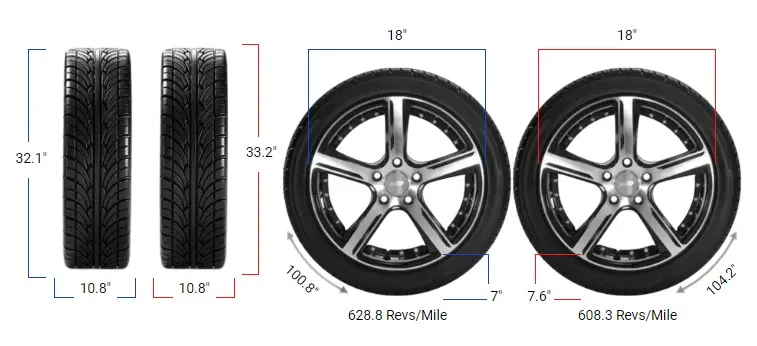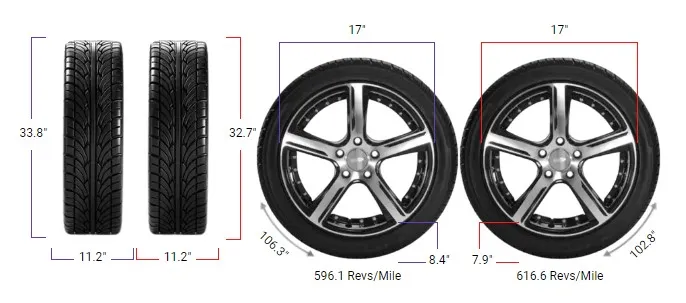245 vs 305 Tires
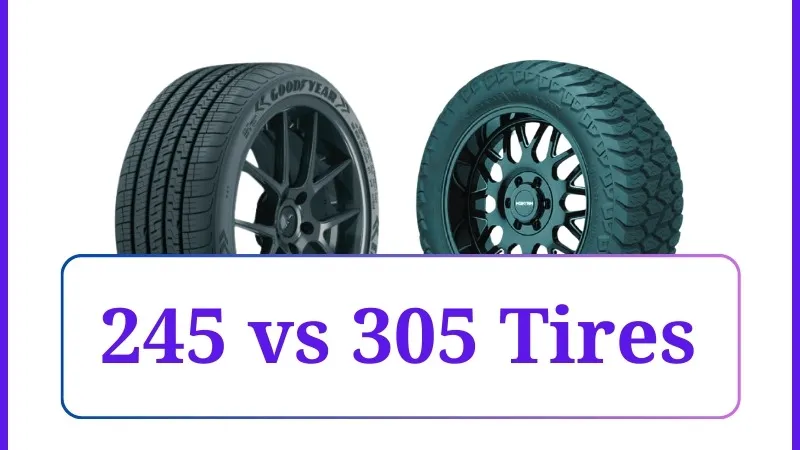
The most obvious difference between 245 and 305 tires is their width. The 215 tires is about 10 mm wider than the 205 tires. A 245 tire has a width of 245 millimeters, while a 305 tire measures 305 millimeters wide.
This difference of 60 mm can significantly impact various aspects of vehicle performance, including traction, fuel efficiency, and handling.
The 305 tire features a much wider contact patch, which generally translates to enhanced traction and stability, especially in cornering and high-speed driving situations.
This wider footprint makes 305 tires an attractive option for those looking to improve their vehicle’s performance or aesthetics, as they can give a more aggressive and sporty look.
On the other hand, 245 tires offer a more balanced approach, providing adequate traction while being more fuel-efficient and better suited for everyday driving.
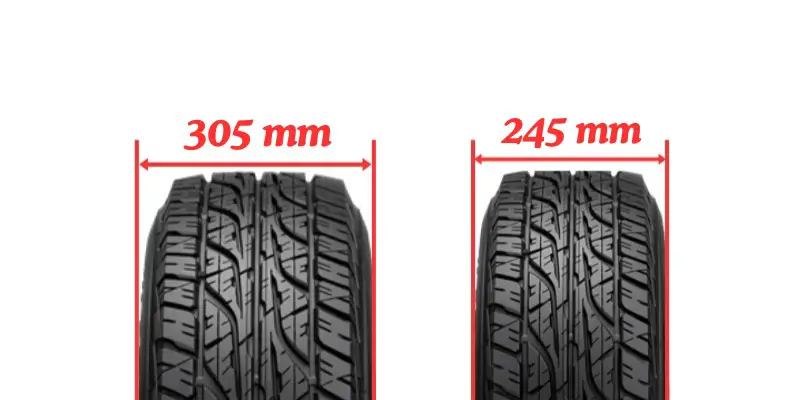
Fitment Guide
Before deciding between 245 and 305 tires, it is crucial to consider fitment. The Ideal Rim Width Range for each tire size is as follows:
- 245 tire: Suitable for rims that are 7.5 to 9.0 inches wide.
- 305 tire: Compatible with rims ranging from 10.0 to 11.5 inches wide.
The Ideal Rim Width Range must overlap for both tire sizes. In this case, there is no overlap between the rim width range of 245 and 305 tires, making a direct swap impractical without changing rims.
On-Road Performance
The 305 tire provides superior handling and stability due to its wider contact patch. This makes it an excellent choice for performance enthusiasts who prioritize traction during high-speed maneuvers and cornering. The extra width allows for better grip, which translates into increased confidence when navigating sharp curves or driving in challenging road conditions.
In contrast, 245 tires offer more nimble handling, particularly in urban environments. The narrower profile allows for lighter steering and improved maneuverability, making 245 tires ideal for everyday driving where ease of handling is more important than maximum traction. This makes them a popular choice for drivers who want a balance between performance and practicality.
Fuel Efficiency: 245 tires are generally more fuel-efficient compared to 305 tires. The narrower width reduces rolling resistance, meaning the vehicle requires less energy to maintain speed. This results in improved fuel economy, which can be a significant advantage for drivers looking to reduce fuel costs.

On the other hand, the 305 tire provides greater traction but at the cost of increased rolling resistance, which can lead to decreased fuel efficiency. For drivers who prioritize performance over fuel savings, the trade-off may be worth it, but it’s an important factor to consider.
Ride Comfort: When it comes to ride comfort, 245 tires tend to offer a smoother experience for daily driving. The narrower profile helps minimize road noise and contributes to a more comfortable ride, especially on highways or city streets. 245 tires are also better at absorbing minor road imperfections, resulting in a less bumpy ride.
305 tires, while offering improved stability, can produce more road noise and a firmer ride due to the larger contact area and stiffer sidewalls. This may be less desirable for drivers who prioritize comfort, especially on long commutes or rough roads. However, the enhanced stability may be worth it for those who frequently drive at high speeds or want a sportier feel.

Off-Road Performance
For off-road driving, 305 tires are generally the superior choice. The wider footprint provides increased traction on loose surfaces such as gravel, sand, or mud, reducing the risk of getting stuck and improving stability when navigating challenging terrains. This makes 305 tires a popular option for trucks and SUVs used for off-road adventures.
245 tires, while capable of handling some light off-road situations, do not offer the same level of traction as 305 tires on loose or uneven terrain. Their narrower width means less contact with the ground, which can make it more challenging to maintain stability on loose surfaces.
However, they still provide sufficient grip for light off-road use, making them a versatile choice for drivers who need to switch between on-road and occasional off-road driving.

Speedometer Impact
Switching between 245 and 305 tires can affect the accuracy of your vehicle’s speedometer and odometer. If the overall diameter of the tire changes significantly, the speedometer may not reflect the true speed of the vehicle.
For example, a larger overall diameter may cause the speedometer to underreport your speed, while a smaller diameter can lead to overreporting.
To ensure accuracy, it may be necessary to recalibrate the speedometer if the overall diameter difference exceeds 3%. Proper calibration is essential to maintain reliable performance metrics and ensure compliance with speed limits.
Benefits of 305 Tires:
- Enhanced Traction and Stability: The wider contact area offers superior grip, particularly in high-speed and off-road situations.
- Aggressive Aesthetics: 305 tires give vehicles a more aggressive and sporty appearance, which can be appealing to performance enthusiasts.
- Improved Off-Road Capability: The larger footprint provides better flotation on loose surfaces, making 305 tires ideal for off-road driving.
Drawbacks of 305 Tires:
- Lower Fuel Efficiency: The increased rolling resistance of 305 tires can result in reduced fuel efficiency, especially during city driving.
- Increased Road Noise: The wider profile may lead to more road noise, which can be noticeable at higher speeds.
Benefits of 245 Tires:
- Better Fuel Economy: The narrower width reduces rolling resistance, leading to improved fuel efficiency, making 245 tires ideal for long commutes.
- Easier Handling: The lighter steering effort makes 245 tires easier to maneuver, particularly in urban environments.
- Quieter Ride: The reduced contact patch helps minimize road noise, contributing to a more comfortable and quieter driving experience.
Drawbacks of 245 Tires:
- Limited Traction: Compared to 305 tires, 245 tires have a smaller contact patch, which can reduce traction, particularly in wet or high-speed conditions.
- Less Aggressive Appearance: 245 tires may not provide the same visual appeal as the wider 305 tires, which can be important for those seeking a sporty look.
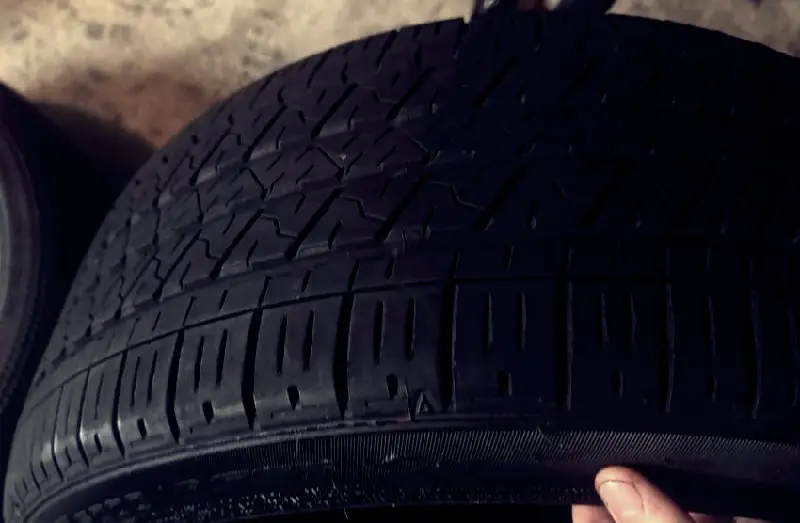
Difference Between 245 and 305 Tires
The main difference between 245 and 305 tires is their width. 305 tires are significantly wider than 245 tires, which affects handling, stability, and overall vehicle performance.
Can I Use 245 Tires Instead of 305?
No, you cannot use 245 tires instead of 305 tires, as their ideal rim width ranges do not overlap. This lack of overlap means the fitment would be unsafe and could negatively impact performance, handling, and safety.
Can I Use 305 Tires Instead of 245?
No, you cannot use 305 tires instead of 245 tires because their ideal rim width ranges do not overlap, making them incompatible. Using a wider tire on a narrower rim would be unsafe and could negatively impact vehicle handling and ride quality.
Can You Put 245 Tires on 305 Rims?
No, you cannot put 245 tires on rims designed for 305 tires. The ideal rim width ranges for these tires do not overlap, meaning they are incompatible and could lead to safety and performance issues.
Can You Put 305 Tires on 245 Rims?
No, it is not possible to put 305 tires on rims designed for 245 tires, as their ideal rim width ranges do not overlap. This would make the fitment unsafe and could negatively affect vehicle handling and overall safety.
Our Observation
Choosing between 245 and 305 tires involves understanding the trade-offs in terms of performance, comfort, and efficiency.
245 tires are well-suited for drivers seeking practicality and comfort, while 305 tires cater to those who value enhanced traction, off-road capabilities, and an aggressive aesthetic.
Always consult a tire professional to ensure that your chosen tire size is compatible with your vehicle and meets your specific driving needs.


